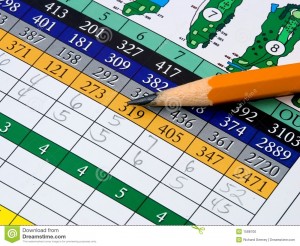No title or headline gets a golfer’s attention more than telling them they can cut multiple strokes off of their score next time they play. As I have mentioned before, the secret to golf is still out there somewhere, according to most golfers. But in reality while there may not be a true secret to golf, there are simple, thought out ways to cut strokes off of your game next time you play. They may be different than what you normally do and at first may be tough to adopt, but in the end it’s all about lower scores.
The first trick is to adjust the par for the course. No, you can’t go playing the par 5’s from the front of the fairway or ignore your tee shot and just drop a ball on the green. What I mean is to assess what your game and handicap are at the time of your round and honestly assess where you need to accept a bogey. For example, a player that routinely shoots 95 should view the par on the course as 82. Most par 72 golf courses have 10 par 4’s, 4 par 3’s, and 4 par 5’s, so take those par 4’s and play more conservatively, even accepting bogey. This is not to say that you won’t play for the par 4, but many players at this level try so hard to hit the ball as far as possible, knowing they may not reach the green in regulation 2 shots, that they end up in deep trouble and make double and triple bogies as a result. I would challenge you to play a hybrid off of the tee (if your driver isn’t working), your favorite iron down the middle, then a wedge onto the green, leaving yourself a putt for par. Will you make it often? Probably not. But if you tap in for an easy bogey instead of a swashbuckling double bogey, you will feel like you have gained strokes on your day. I’m willing to bet that if you take this route you will be shocked at how good your score is for the day. So figure out your tendencies and ability level, and make the game simpler and adjust the par for the day.
Another way to make some quick gains on the scorecard is to play for the middle of the green on all full swing approach shots. Obviously this depends on your ability level, but if you are among the majority of golfers who shoot in the 90’s or higher, this strategy has merit. Interestingly, some country clubs will play one day tournaments with no flag sticks in the greens, so players won’t know where the hole is until they get up on or around the green. It’s amazing how well most golfers score and how many greens in regulation they hit! The reason is that in the absence of a flagstick, they take the safest route, which also happens to be the route that leads to better overall scores. Hitting more greens in regulation, with reasonably good putting, can lead to better numbers on the scorecard virtually every time.
In addition to these two options, you also should really spend more time on the putting green. I know, you don’t want a way to save strokes that involves practice, but this one really matters. If you do hit more greens in regulation you will most certainly have a lot of very long putts that you need to get up close to the hole. So many golfers focus on the golf swing and what they do away from the green, almost blocking out the fact that they may have three-putted a few times during the round. That’s like setting money on fire – wasteful! Remember that those long putts that you don’t get close to the hole count as much as any other stroke, so why don’t you spend just as much time on those as you do on your driver? Learn to practice the putts that matter. Based on PGA Tour information, Tour players – the best in the game – make only 49% of their putts from 8 feet. So stop practicing those! Work on the longer putts of 20 feet and beyond, then work on the putts from 5 feet and in to the hole. When you practice getting your lag putts close and making the short ones, you are able to pair these 2 skills on the golf course and stop throwing away shots. No that’s like making money instead!
Finally, you need to see the “fat” on the golf course. What does this mean? It means that you need to start paying better attention to what the golf course architects give you on each course. When I play with amateurs, it amazes me how slow they can play but how fast they make decisions. Many players will never be ready to play, but pull a club without ever taking into account what I call the “fat” area on the hole – the area that has the least amount of trouble and is your bail out area. Most every golf course has these areas on holes, but most high handicappers don’t know how to look for them. When there is water on the right, the only thing they see is the water. Better players choose their club wisely but most of all see the open areas away from the water, even if it means missing in the rough. Live to play another day! Learn to look behind the pin for more green, shorter in the fairway for more room, and even missing the green a touch short of that front pin so you can have an easy chip and not have to deal with that deep bunker. Open your eyes to the “fat” parts of the golf course and start saving strokes and managing your game like a better player.
So saving strokes is never easy, and having better technique is always helpful. But the next time you go out, have a plan in place and use a few of these tips to save some strokes on the scorecard and enjoy your round a whole lot more.




